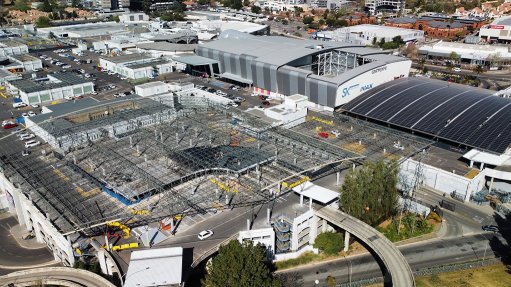
Solar photovoltaic panels on the roof of Eastgate Shopping Centre
An additional 5.74 MW of solar power has been added to the fast-track project being undertaken at Eastgate Shopping Centre in Gauteng, while trading continues.
As part of the ongoing work implemented by South African black-owned contractor Concor, another 30 000 m2 of solar photovoltaic (PV) panels have been added to the roof of the shopping centre, east of Johannesburg.
“We are conducting the project in stages so we limit work to one confined area at a time, leaving as much parking available to shoppers as possible,” says Concor contract manager Martin Muller. “We also meticulously manage the traffic flow to ensure convenience and safety.”
The company explains that the location of the solar panels on the roof top has presented various challenges to the construction process. The low load bearing capacity of the roof top parking area, for instance, makes it off limits to cranes and readymix trucks. This requires Concor to use small dumpers for transporting concrete, and the company designed special scaffolding to accommodate conveyors carrying concrete into the column formwork.
The weight of the structural steelwork underpinning the large domes of solar panels is significant. This has meant that the concrete columns securing the steelwork have to be drilled and dowelled onto the existing columns supporting the roof top slabs, thereby transferring the weight to the centre’s foundations. This requires careful scanning and opening up of the column heads, to avoid any damage to the post-tensioned cables.
Muller explains that the risk of the solar panel structure being lifted by high winds is also a factor that has to be considered during construction. This requires that the dowels have a pull-out strength of 12 t, or 120 kN, each, and these are tested to ensure compliance with the specification.
“To speed up the project, we had the steel girders and trusses premanufactured and ready for installation,” he says. “The specific configuration of each dome was determined by the position of the concrete stub columns, so this demanded very accurate design parameters for the manufacture and installation of the steelwork.”